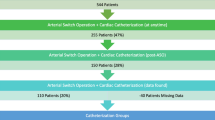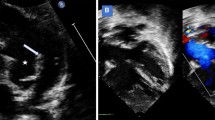Abstract
Perventricular Melody valve placement has been described as a bailout approach or alternative RVOT approach in patients >30 kg. We present three patients <20 kg and two patients with limited venous access, where we electively performed the perventricular approach. Retrospective analysis of patients <30 kg and vascular access limitation undergoing elective hybrid pulmonary valve replacement were reviewed. The subcostal approach was performed without sternotomy with the sheath introduced through the diaphragmatic surface of the right ventricle. Diagnoses included tetralogy of Fallot (n = 3) and truncus arteriosus (n = 2). Mean weight was 16.2 kg (range 4.7–28.1 kg). Four patients had RV–PA conduits (size: 14–21 mm), and the fifth patient had a transannular patch. All patients met criteria for surgical valve replacement. Technical success was 100%. In two patients with absent pulmonary valve, the stent migrated during advancement of the delivery sheath. These stents were anchored in the distal main pulmonary artery (n = 1) or branch pulmonary artery (n = 1) without sequela. Tricuspid valve chordal injury occurred in one patient, where transesophageal echocardiogram (TEE) was not utilized. No patient required conversion to cardiopulmonary bypass. One patient with absent pulmonary valve died on follow-up as a consequence of severe airway compromise. Our initial experience demonstrates that the perventricular valve can be placed safely in small-sized patients. Advancement of the melody ensemble may be difficult and may cause stent migration. We conclude that the technique is feasible in small-sized patients and that prevention of complications includes placement of the stent at the time of the valve and TEE assistance in reducing tricuspid valve injury.





Similar content being viewed by others
References
Geva Tal (2013) Indications for pulmonary valve replacement in repaired Tetralogy of Fallot: the quest continues. Circulation 128:1855–1857
Bonhoeffer P, Boudjemline Y, Zakhia S et al (2000) Transcatheter implantation of a bovine valve in pulmonary position: a lamb study. Circulation 102:813–816
Bonhoeffer P, Boudjemline Y, Saliba Z et al (2000) Percutaneous replacement of pulmonary valve in a right-ventricle to pulmonary artery prosthetic conduit with valve dysfunction. Lancet 356:1403–1405
Cheatham JP, Hellenbrand WE, Zahn EM et al (2015) Clinical and hemodynamic outcomes up to 7 years after transcatheter pulmonary valve replacement in the US melody valve investigational device exemption trial. Circulation 131(22):1960–1970
Zahn EM, Hellenbrand WE, Lock JE et al (2009) Implantation of the Melody transcatheter pulmonary valve in patients with a dysfunctional right ventricular outflow tract conduit. J Am Coll Cardiol 54:1722–1729
Berman DP, McElhinney DB, Vincent JA, Hellenbrand WE, Zahn EM (2014) Feasibility and short-term outcomes of percutaneous transcatheter pulmonary valve replacement in small (<30 kg) children with dysfunctional right ventricular outflow tract conduits. Circ Cardiovasc Interv 7(2):142–148
Cubeddu RJ, Hijazi ZM (2011) Bailout perventricular pulmonary valve implantation following failed percutaneous attempt using the Edwards Sapien transcatheter heart valve. Catheter Cardiovasc Interv 77:276–280
Berman DP, Burke R, Zahn EM (2012) Use of a novel hybrid approach to salvage an attempted transcatheter pulmonary valve implant. Pediatr Cardiol 33:839–842
Simpson KE, Huddleston CB, Foerster S et al (2011) Successful subxyphoid hybrid approach for placement of a Melody percutaneous pulmonary valve. Catheter Cardiovasc Interv 78:108–111
Phillips A, Nevin P, Shah A, Olshove V, Garg R, Zhann E (2016) Development of a novel hybrid strategy for transcatheter pulmonary valve placement in patients following transannular patch repair of Tetralogy of Fallot. Catheter Cardiovas Interv 87:403–410
Amin Z, Berry J, Foker J et al (1998) Intraoperative closure of muscular ventricular septal defect in a canine model and application of the technique in a baby. J Thorac Cardiovasc Surg 115:1374–1376
Amin Z, Xiaoping Gu, Berry J et al (1999) Periventricular closure of ventricular septal defects without cardiopulmonary bypass. Ann Thorac Surg 68:149–154
Kang SL, Tometzki A, Caputo M et al (2015) Longer-term outcome of perventricular device closure of muscular septal defects in children. Catheter Cardiovasc Interv 85:998–1005
Amin Z (2006) Available transcatheter pulmonary valves: perventricular technique with the Shelhigh valve. In: Hijazi Z, Bonhoeffer P, Feldman T, Ruiz C (eds) Transcatheter valve repair. Taylor & Francis, Thames, pp 89–95
Zampi J, Hirsch-Romano J, Goldstein B, Shaya J, Armstrong A (2014) Hybrid approach for pulmonary atresia with intact ventricular septum: early single center results and comparison to the standard surgical approach. Catheter Cardiovasc Interv 83:753–761
Holoshitz N, Ilbawi M, Amin Z (2013) Perventricular melody valve implantation in a 12 kg child. Catheter Cardiovasc Interv 82:824–827
Holoshitz N, Kenny D, Hijazi ZM (2014) Hybrid interventional procedures in congenital heart disease. Methodist Debakey Cardiovasc J 10(2):93–98
Sosnowki C, Matella T, Fogg L, Ilbawi M, Nagaraj H, Kavinsky C, Wolf A, Diab K, Caputo M, Kenny D (2016) Hybrid rehabilitation of the native RVOT: pulmonary artery plication followed by transcatheter pulmonary valve replacement: comparison with surgical PVR. Cathet Cardiovasc Interv 88:804–810
Acknowledgements
The authors express there deep gratitude to Dr. Ilbawi who was involved with the first two cases and Dr. Polimenakos who was involved in case number 4.
Author information
Authors and Affiliations
Corresponding author
Ethics declarations
Conflict of interest
Dr. Amin is Proctor for Edward’s THV Pulmonic Valve. No other authors have any conflict of interest.
Rights and permissions
About this article
Cite this article
Gupta, A., Kenny, D., Caputo, M. et al. Initial Experience with Elective Perventricular Melody Valve Placement in Small Patients. Pediatr Cardiol 38, 575–581 (2017). https://doi.org/10.1007/s00246-016-1550-0
Received:
Accepted:
Published:
Issue Date:
DOI: https://doi.org/10.1007/s00246-016-1550-0




